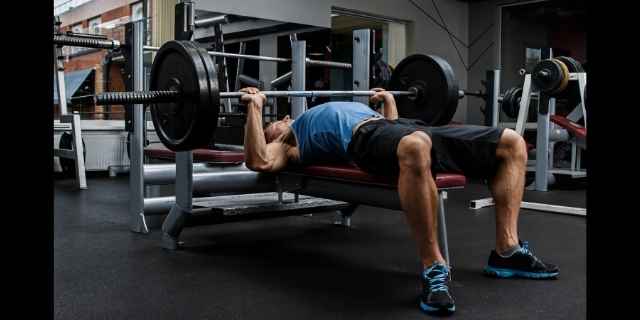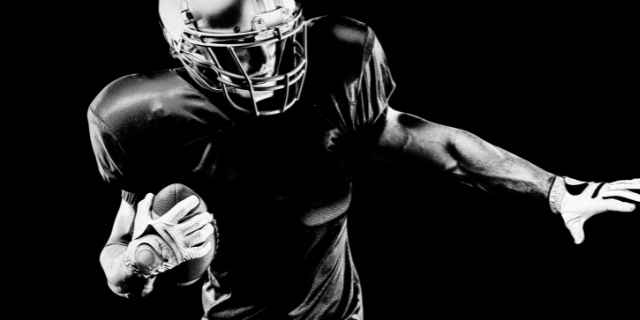Just how strong are professional rugby players? This article looks at how much weight that elite rugby players can lift in the gym.
We also look at typical weight training schedules for international players. And we look at how they match up in strength to NFL players and professional powerlifters.
How Much Do Professional Rugby Players Bench Press?

Across sports, the bench press is the gold standard for measuring upper body strength. So how do Rugby players measure up? The answer is very well.
All the numbers mentioned here are the player’s one rep maximum. This means that it’s the top weight that they can do only once. This is something that is attempted very rarely, and probably never in season.
As a minimum, a player at the professional level is expected to bench between 1.3 to 1.5 percent of their body weight. Many players exceed this number easily.
A list compiled a few years ago of top professional players shows a range from 137kg to 230 kg.
This is some serious weight, particularly for athletes in a sport that requires high amounts of running without a break.
But how does it compare to other top power sports? Let’s look at NFL players and professional powerlifters
NFL Players

While the NFL keeps track of bench press statistics, the focus is on how many reps a player can bench at 102 kg. This doesn’t mean that some NFL players don’t have impressive one rep maximum presses.
The upper body strength requirements of NFL football are highly variable by position. A lineman needs a lot more strength than backs or receivers.
A lineman in the NFL would be expected to have a one-rep maximum on the bench of between 204 kg and 250 kg.
This is somewhat higher than what we see in rugby, but really not by that much.
It’s also not surprising that NFL players may press a bit more.
Consider that NFL requires maximum power generation for short periods, followed by a short rest. This allows (and demands) that players prioritize strength in a way that would be counterproductive in rugby.
Want to see a comparison of size in these two sports? Check out our article on whether NFL players are bigger than rugby players.
Powerlifting
Not surprisingly, powerlifters are the clear winner here.
Their sport consists entirely of doing only three lifts, one of which is the bench press. So, all their training time is spent on improving these lifts.
They actually avoid cardio training as it’s believed to be harmful to strength gains. Also, they use all kinds of aids. The belts are easily recognizable.
They also have a type of shirt with an elastic front that makes it almost impossible to move your arms back.
The powerlifting record for the bench is 508 kg, as of 2021. The raw record (no bench shirt) is 355 kg.
How would rugby players do in a powerlifting competition?
At least one elite rugby player has gone on to do well in powerlifting after his playing days were over. Australian international Murdoch Alistair benched 227 kg (raw) in a world competition in 2014.
It may surprise you that he was a winger, not a burly forward.
However, a current rugby player wouldn’t get very far in an elite powerlifting competition. The kind of training needed to be competitive in these lifts would impair performance on the rugby field.
How Much Do Professional Rugby Players Squat?
While the squat doesn’t get as much attention from the general public, it is a vital exercise for building leg power.
It is not unreasonable to expect a front-row player at the international level to be able to squat 2.5 times their body weight. This means a squat of over 280 kg for a 115 kg player.
This puts rugby in the upper echelons of strength requirements across all sports.
One young prop forward
I live in Ireland, and I started hearing a few years ago about the impressive gym stats of a prop playing at the under-20 level. Words get out quickly!
The prop was Andrew Porter who has since become a fully capped Irish international. He would have become a British & Irish Lion but had to withdraw from the tour due to injury.
Andrew Porter is known to have a squat max of 325kg. That is serious weight!
What about NFL?
An NFL offensive lineman can be expected to squat anywhere between 315kg to 360 kg.
While this is somewhat higher than what a front-row rugby player is doing, these also tend to be much heavier players.
Rugby does quite respectably in the squat when compared with NFL football.
Powerlifting
Again, and for much the same reason as in the bench, powerlifters dominate. The squat is one of the three exercises that they compete in.
The world powerlifting record, done while wearing an elastic squatting suit and knee wraps, is 595 kg. The raw record, with no suit or wraps, is 490kg.
For sheer strength in the squat, no one in any sport really comes close to the top powerlifters.
How Often Do Professional Rugby Players Lift Weights?

How often players lift weights is determined by several things, including
- whether they are in season or off-season
- their effort and minutes spent playing in a competitive match
- the amount of work they are doing in skills sessions.
Strength is very important to the player, but they can’t let training fatigue slow down or negatively affect their match performance. It also shouldn’t get in the way of skills sessions.
Typical weights schedule for two international players
Here are two different schedules at international level.
The first is from an interview with an England international (Thomas Waldrom). The second schedule was devised for the Welsh national team.
As you can see, they are fairly similar. These elite players lift weights three times a week.
| Day | English International | Welsh International |
| Saturday | match day | match day |
| Sunday | Recovery | recovery |
| Monday | upper body weights | lower body weights |
| Tuesday | lower body weights | upper body weights |
| Wednesday | day off | day off |
| Thursday | Weights | only cardio |
| Friday | captain’s run | upper body weights |
It’s important to note that there is no hard and fast rule.
Professional teams track workload and biometric factors for their players very rigorously. If you want to learn more, check out our article on GPS trackers in rugby.
The coaches and physios constantly adjust training based on these metrics.
But there are some general guidelines that emerge if you look at the training programs like I showed above. Let’s look in detail at a week’s schedule for weights.
Importance of recovery days

When match day is a Saturday, this means that Sunday is a recovery day. The players will do some basic stretching but not much else.
The bulk of the heavy training is front-loaded at the beginning of the week, usually Monday and Tuesday. This allows players to work hard with enough of a distance to the next match minutes.
Wednesday is another recovery day. Actually, this is a “day off” for professional players. They work at weekends, so it’s important that they have time for life outside of the work environment.
There is a clear pattern of tapering off workload as match day approaches. Monday and Tuesday often have double training sessions. These are much less likely to happen as the week progresses.
One schedule has weights on a Thursday, followed by the Captain’s Run on a Friday. The Captain’s Run is about an hour of light cardio training on the match pitch.
The other schedule has solely cardio work on the Thursday with some light upper body weights on the Friday.
What Kind Of Weight Training Do Professional Rugby Players Do?
As we’ve seen, the heavy weight sessions are on the Monday and Tuesday. One day will focus on lower body and the other day on upper body strength.
A heavy leg training session will consist of squats and deadlifts.
The upper body session will center around bench press, pull-ups, and possibly military press.
After the recovery day on Wednesday, the player might be back to the weights. Some trainers only allow two weight sessions a week during the season.
A third training session would most likely be focused on Olympic lifts to build explosiveness. This includes power cleans, snatches, and high pulls.
All weight exercises, Olympic or otherwise, are performed with a focus on moving the weight at speed for explosiveness.
Other Stats For Rugby Players
This article is about strength, but what about height? Check out our article on the average heights of rugby players at different positions.
So, we’ve looked at what players do in the gym. But what they do out on the pitch is more important!
Check out our article on how far rugby players run. You may be surprised at the distances they cover during a match.